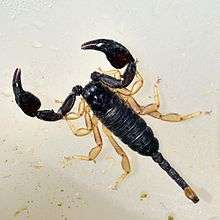Euscorpius flavicaudis
| European yellow-tailed scorpion | |
|---|---|
 | |
| Scientific classification | |
| Kingdom: | Animalia |
| Phylum: | Arthropoda |
| Subphylum: | Chelicerata |
| Class: | Arachnida |
| Order: | Scorpiones |
| Family: | Euscorpiidae |
| Genus: | Euscorpius |
| Species: | E. flavicaudis |
| Binomial name | |
| Euscorpius flavicaudis De Geer, 1778 | |
Euscorpius flavicaudis, or the European yellow-tailed scorpion, is a small black scorpion with yellow-brown legs and tail (metasoma). Adults measure about 35–45 millimetres (1.4–1.8 in) long. It is a fossorial scorpion with relatively large, strong claws (pedipalps) and a short, thin tail.
Distribution
The native range of E. flavicaudis extends through Northwest Africa and Southern Europe, but it has also been introduced into the United Kingdom and Uruguay. It is the northernmost scorpion in the world and the only one in the UK. The main colony in Britain is in Sheerness Dockyard, the Isle of Sheppey, Kent.[1]
Habitat
Warm temperate climate. The species can be found in built up areas. In the UK, the scorpion occupies cracks and holes in walls where the mortar pointing has crumbled away.
Venom
It is a mildly venomous, harmless scorpion, which will rarely use its stinger. The sting is like a bee sting to humans.[2]
Reproduction
The gestation period is 10–14 months, depending on the availability of food and the prevalent climate.
After reproduction with the male a pregnant female will look for a secluded humid place to give birth to live young, from a few to about thirty, which are white, soft and swollen. The mother will raise her forelegs to facilitate the release of the young, which will then climb onto her back, where they will remain until the first moult (approximately six days). After that, the scorplings will start to wander around the surrounding area but will remain together close to the hiding place for a few days. The young scorpions will reach adulthood after one or two years.[3]
Feeding
Euscorpius flavicaudis is an ambush predator, lying motionless at the entrance to its lair, but moving quickly to capture prey that wanders by. The main prey of E. flavicaudis are woodlice, although most small insects are taken. Cannibalism has been noted in colonies of E. flavicaudis. Scorpions may go for long periods of time without food.